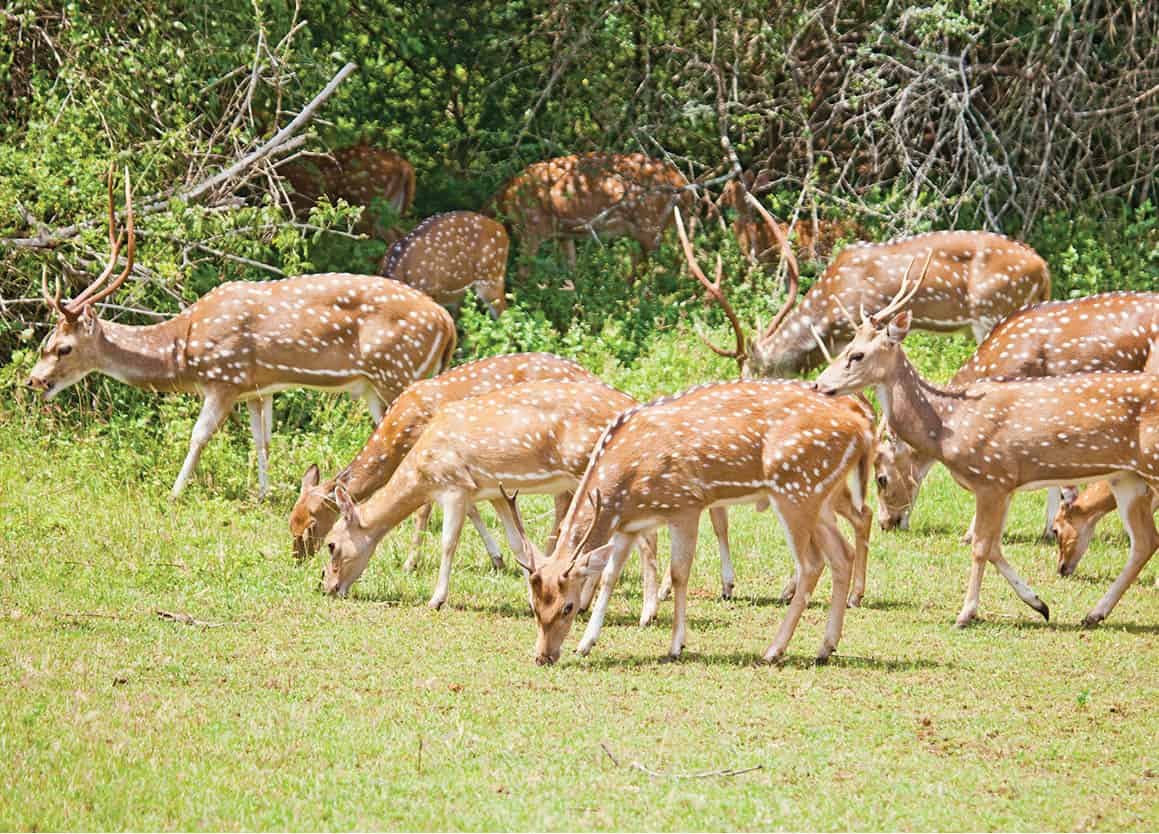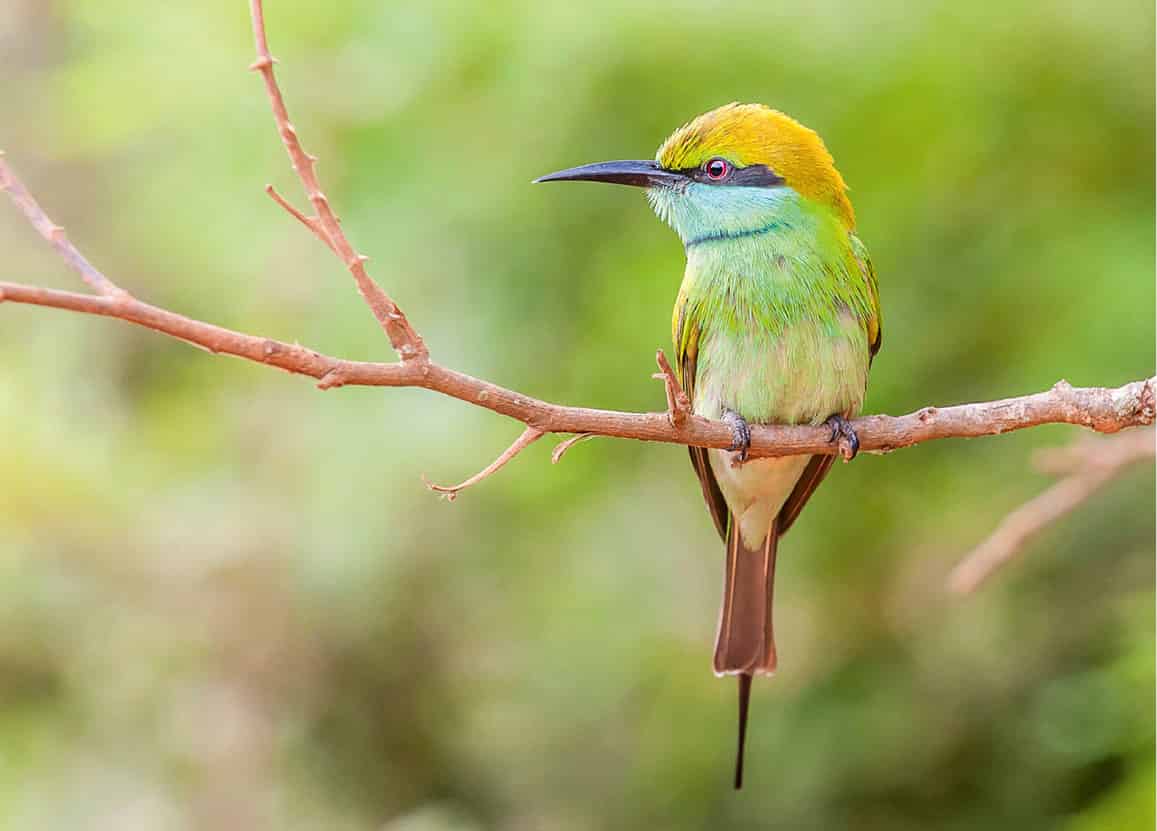Distance: 67km (42 miles)
Time: A full day
START: Hambantota
END: Yala National Park
points to note: The best way to visit the park is to take an early jeep tour at around 6am to view bird life, or at around 3pm for elephants. Leopards can sometimes be seen, but sloth bears are elusive. The park is closed every year from 1 September to 16 October, when animals move elsewhere in search of water. This tour follows route 11 if you take the A2 for 128km (80 miles) east from Galle; alternatively, after route 8 drive 88km (55 miles) south from Ella on the A23/A2 to pick it up at Tissamaharama.
The most famous of Sri Lanka’s 22 national parks, Yala covers a vast swathe of countryside in the southeast of the island beyond Tissamaharama, protecting a diverse range of habitats including scrub jungle, tanks, brackish lagoons and swamps. Much of the park is closed to visitors, but the area which is open has probably the richest and most varied collection of wildlife in the country, and is the best park in the country for viewing the biggest variety of mammals in a single day. Wildlife includes a substantial elephant population, elusive sloth bears, gorgeous bird life and, most famously, a significant leopard population. Although they’re not easy to spot, you’ve reasonable odds of seeing one if you spend some time in the park with a reputable outfit.

In Yala National Park
iStockphoto
Hambantota
Around 50 miles (80 km) east from Galle, the town of Hambantota 1 [map] was the focus for massive development during the tenure of former president and local son Mahinda Rajapakse, with projects including the construction of a massive Chinese-sponsored port and the island’s second international airport. Turn off the highway that bypasses Hambantota to drive into the town, one of the biggest along the south coast. The town has Sri Lanka’s largest population of Malay Muslims – its name is said to derive from sampans, the boats that the Malays arrived in, and tota, or harbour. You will notice an unusually large number of mosques here, as well as the occasional East Asian-looking face amid the Sri Lankan crowds.
Hambantota is also known as the island’s major centre of salt production, which is collected from the enormous evaporating salt pans that ring the town, and for its curd. Made from buffalo milk, it is sold from many roadside stalls and makes a delicious treat – look for the strings of clay pots hanging up outside local shops. For refreshment try the Hambantota Rest House, see 1 [map].

A green bee-eater in the park
iStockphoto
Tissamarahama
Return to the coastal road to drive through lush, low vegetation that gives way to thorny plants and small shrubs, typical of the dry zone. After 15km (9 miles) the road passes Bundala National Park, famed for its aquatic bird life, particularly the enormous flocks of flamingoes which can often be seen here. Beyond here, the road gradually turns inland towards Tissamaharama 2 [map] (or ‘Tissa’, as it’s usually called), one of the most historic towns in the south. Under the name of Mahagama it formerly served as the capital of southern Sri Lanka during the Anuradhapuran period, and still has a pair of huge stupas and a collection of ancient tanks.
Safari jeeps
If you are not going to stay close to Yala, safaris can easily be arranged in Tissa, or you can arrange to be picked up at the Rajapakse international airport by the Yala Safari Camping team (tel: 077 3175 482).
There are many guesthouses in the town; try lakeside The Safari, see 2 [map] for lunch, or alternatively, head to nearby Refresh, see 3 [map] restaurant.

On a jeep safari
iStockphoto
Kirinda
To reach Yala National Park, set off southwards towards the coast along the road to Kirinda, 10km (6 miles) away. At Kirinda 3 [map] there is a lovely view of the southern coast from a temple atop a rock. This is the spot where Vihara Mahadevi, the mother of the Sinhalese hero Dutugemunu, is said to have landed after she been cast adrift at sea in a boat as a sacrifice by her father to placate angry gods who had caused the sea to rise, flooding the coast – an ancient legend which perhaps encapsulates memories of an earlier Sri Lankan tsunami.
Signs of human habitation become sparse as the road winds for another 33km (21 miles) along the coast through scrubland, salt pans and swamps where buffaloes wallow. Watch out for peacocks preening themselves and the grey silhouettes of wild elephants, looking like boulders, in the distance. Just before the entrance to the park is a signpost to the Cinnamon Wild Yala resort, see 4 [map], the closest hotel to the park and the most convenient place to stay or have a meal. Safaris can be arranged with the drivers of jeeps parked at the hotel’s gate.
Yala National Park
By hired jeep it takes about 10 minutes to drive to the Yala National Park 4 [map] from the Cinnamon Wild Yala hotel. There is a small museum near the entrance showing the development of the park, as well as models and skeletons of animals found there.
In addition to the entrance fee, you have to pay a tracker assigned by the park. The trackers are experienced in the ways of the jungle and sometimes prove to be fascinating companions, spotting the best places to find wildlife, including herds of deer, buffaloes, crocodiles, sambhurs, monkeys, flying squirrels and birds that migrate from India and as far afield as Europe including painted stork, heron, ibis, green bee-eater, green pigeon and Malabar pied hornbill. These spots are usually near waterholes, where animals come to drink in the evening and early morning.

A thirsty leopard stops for refreshment
Noel Rodrigo/Leopard Safaris
Elephants and leopards
The greatest thrill, however, is the sight of wild elephants and leopards. The elephant found in Sri Lanka belongs to the same subspecies as that found throughout Asia. These huge creatures move majestically and are seldom bothered about visitors, except when they feel threatened. The real highlight of Yala is its remarkable population of leopards, reckoned to be the densest anywhere in the world, with 60–70 animals living in the area of the park open to visitors. Sightings of these notoriously difficult-to-spot and largely nocturnal animals are far from guaranteed, but spend a day in the park and you’ve got a reasonable chance, with animals sometimes seen sat atop the various rock outcrops which dot the park preening themselves in the sun, dangling from the branches of a tree overhead, or occasionally sauntering casually down one of the park’s dirt tracks.
Food and drink
1 Hambantota Rest House
Hambantota [map]; tel: 047-222 0299; daily noon–3pm, 7–10pm; $$
Engagingly time-warped government rest house with fine views of the harbour below and coastal sand dunes beyond. The dining room is a fine old colonial period piece offering a range of reasonably prepared and inexpensive à la carte dishes including fresh fish and the inevitable rice and curry, served in huge portions.
2 The Safari
Tissamaharama [map]; tel: 011-558 58 58; www.chcresorts.com; daily 12.30–3pm, 7.30–10.30pm; $$$
Overlooking the shores of the idyllic Tissa Wewa lake, this long-established resort, recently given a major makeover and upgrade, is a decent spot for lunch, with a good selection of local and international mains, including fish fresh out of the adjacent lake.
3 Refresh
Akurugoda, Tissamaharama [map]; tel: 047-223 7357; daily 5am–10.30pm; $$$
This large and always-busy restaurant is an almost obligatory port of call for all tourists visiting Tissa, set in a spacious outdoor pavilion. The huge menu features all sorts of Sri Lanka and international dishes with various levels of success, although the fish and seafood is usually pretty good, and the huge rice and curry spreads are amongst the best in the country, all delivered with efficient and friendly service.
4 Cinnamon Wild Yala
Kirinda, Tissamaharama [map]; tel: 047-223 9450; www.cinnamonhotels.com/cinnamonwildyala; daily 7–10.30am, 12.30–3pm, 7.30–10.30pm; $$$$
Long-running jungle resort (formerly Yala Village) where elephants often pop in. Choose from snacks in its poolside lounge bar and buffets with a wide selection of Western and Eastern dishes in the open-sided restaurant with views out over the jungle.
